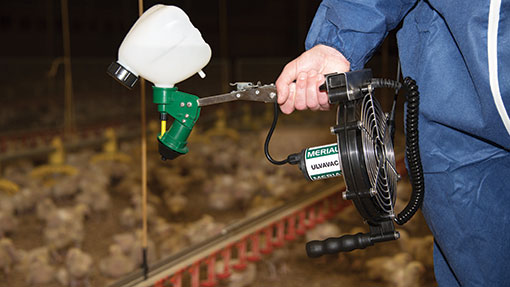Top tips for spray vaccinating chickens

While spraying is an excellent way of carrying out mass vaccinations for respiratory diseases in broilers and pullets, using the wrong equipment can have disastrous consequences.
Traditional pressure sprayers in particular can produce very variable results, warns Merial Animal Health avian manager and veterinary adviser Helen Houghton.
“Because of the range of droplet sizes produced by pressure sprayers, some vaccine will go too far into the bird’s respiratory system and may cause side effects, while droplets that are too large will simply fall to the floor and be wasted,” she says.
“The danger is that you end up with some birds that are not vaccinated at all and some that have side effects from the vaccine.
“With this type of pressure sprayer, the droplet size changes as the level goes down. You start with very small droplets and these gradually increase to droplets that are too big. In an ideal world what we need is a consistent size of droplet – somewhere between 50 and 100 microns.”
Merial was so concerned about the issue of ensuring consistent droplet size and increasing the effectiveness of spray vaccination that it approached Micron Sprayers, a company which already had extensive experience of producing sprayers for agriculture and industry. Today its products are used all over the world – wherever precise application of sprays is required.
“Basically it uses a spinning disc which uses centrifugal force,” explains operations director John Clayton. “By controlling the speed of the disc, it is possible to regulate the size of the droplets with a much greater degree of accuracy. We call this method ‘controlled droplet application’ or ‘CDA’.
“We now produce a number of sprayers in conjunction with Merial, including the UlvaVac for use in broiler houses, the SpraVac and SprayCart which allow a number of levels of layers to be vaccinated at the same time, and the AccuDos 25 for day-old chicks.”
Ms Houghton says the UlvaVac has greatly improved the accuracy and effectiveness of vaccinating chickens compared with traditional garden knapsack sprayers, and is now widely used in the UK industry and throughout the world.
“Because the system has been specifically designed for administering vaccines, it will give the best results every time and is more cost-effective for producers. As with any vaccination procedure, there are guidelines which have to be followed to ensure top performance of the equipment.” (See Top tips, below.)
Top tips for using the Ulva Vac
- Prepare the day before you vaccinate
- Ensure you have the right number of doses of vaccine for the shed you are vaccinating
- Make sure the battery is fully charged
- Clean the sprayer thoroughly
- Use de-ionised water or, if you are using mains or borehole water, add in a stabiliser
- Plan and time your route around the shed to ensure that you can cover the whole area twice
- Once you are ready to go, turn the lights down to ensure the birds settle
- Turn off the ventilation to avoid turbulence of the air
- Hold the sprayer level to ensure even distribution and to one side so that the fan has a clear air supply
- When using live vaccines, carry out the procedure as soon as they are reconstituted
- Once you have completed the vaccination, switch the ventilation back on immediately. It will not affect the uptake of the vaccine
- how it works
- The UlvaVac sprayer is battery powered. As well as spinning the all-important disc that produces the uniform droplets, the battery also powers a fan which distributes the vaccine over an area of up to three metres long and a metre wide. The 900ml of water that is contained in the machine’s reservoir should last about 20min when a yellow nozzle is used.
